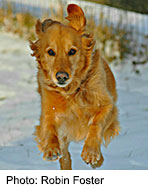- Navigating Your Midlife Crisis: Embracing New Possibilities
- City Raccoons Showing Signs of Domestication
- Mapping the Exposome: Science Broadens Focus to Environmental Disease Triggers
- One Week Less on Social Media Linked to Better Mental Health
- Your Brain Changes in Stages as You Age, Study Finds
- Some Suicide Victims Show No Typical Warning Signs, Study Finds
- ByHeart Formula Faces Lawsuits After Babies Sickened With Botulism
- Switch to Vegan Diet Could Cut Your Greenhouse Gas Emissions in Half
- Regular Bedtime Does Wonders for Blood Pressure
- Dining Alone Could Mean Worse Nutrition for Seniors
When, Where Did Dogs Become Man’s Best Friend?


Dogs are practically part of many human families, but it wasn’t always that way.
At some point in history, biologists think humans figured out how to tame wolves. Over time, the ones that lived with humans evolved to have traits more suited to being treasured pets than fearsome predators.
Exactly when and where that process began has been the subject of fierce debate. Now, research from Finland moves the origins of the dog-human bond far back in history, to the hunters of ancient Europe.
“There have been a lot of studies looking at this question,” said Kathryn Lord, an evolutionary biologist who studies the origins of dog and wolf behavior.
“A lot of different people have a lot of different answers, and they all disagree with each other, of course,” said Lord, who is currently an adjunct professor at Gettysburg College, in Pennsylvania.
Previous studies comparing genetic material from ancient and modern dogs claimed that the first dogs began to be domesticated by farmers in the Middle East or Asia about 15,000 years ago.
Today a new study, published in the Nov. 15 issue of Science, suggests yet another point of origin for man’s best friend.
By comparing genetic material from ancient and modern dogs and wolves, an international team of researchers says it looks more likely that dogs were first domesticated earlier than was previously believed.
“All our modern dogs have some roots in Europe,” said Olaf Thalmann, a postdoctoral research fellow at the University of Turku, in Finland. “What we think is likely is that it happened something like 19,000 to 32,000 years ago.”
During that time, humans were nomadic. They hunted and gathered food to survive. So if that’s when wolves were first tamed, Thalmann believes both species somehow began to use each other to track and kill food.
“One could easily imagine that there was a mutually beneficial relationship between dogs and humans,” he said. “You can think the wolf might have benefited from the leftovers at hunting sites. On the other hand, humans might have been benefiting from wolves [being] around during hunting,” Thalmann added. Wolves might have driven animals in a certain direction, or helped to protect humans from other predators.
There is some precedent for the idea that two species can work together to hunt. A 1992 study from the University of California, Davis, found that coyotes and badgers work together to hunt small animals like ground squirrels. The coyote chases down the prey while badgers plug the underground escape routes to keep the small animals from getting away. The relationship increases their mutual hunting success. The pairs catch about a third more animals together than if they go it alone.
Still, Lord thinks it’s unlikely that humans domesticated the dog to help with hunting. One theory is that ancient humans began to raise wolf puppies and started to select the most docile animals among them.
“It doesn’t ring true to me. I’ve raised wolf puppies. And that’s a really difficult process in order to do it properly,” explained Lord, who was not involved with the new study.
She thinks early humans probably didn’t have the resources to make sure young wolves got regular feedings of first milk and then regurgitated meat — their standard diet.
“That’s a lot of energy to put into something. You’re already living on the edge of survival yourself,” Lord noted.
“We don’t see any evidence of any of this happening, either,” she added. “We don’t see hundreds of baby wolves near humans. It’s just not in the archeological evidence.”
Lord offers the alternative theory, that dogs domesticated themselves by beginning to eat human garbage after humans settled down to become farmers.
“When we sit in one place, we generate a lot of garbage and refuse,” she pointed out. “And that, to this day, is a really valuable niche for a lot of animals. A lot of animals can survive by eating our garbage.”
What’s more, she added, most gene studies are based on faulty assumptions about what gene changes in dog and wolf DNA mean. She said that experts have poked holes in many such gene studies.
“It’s always good to go out and look. It’s great that they went out and gathered the data,” Lord said.
However, “I don’t think it’s gotten us any closer to understand where dogs come from,” she concluded.
More information
For more on dog evolution, head to the Public Broadcasting Service.
Source: HealthDay
Copyright © 2025 HealthDay. All rights reserved.










